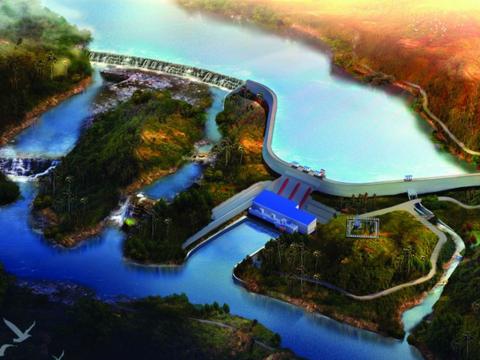By Abdul Tejan-Cole
As a result of its exceptional hydrography, Guinea could be the powerhouse of West Africa. Experts believe it has the potential to generate more than 6000 MW, more than ten times the current size of its national grid. A key reason for this is that Guinea is the source of over half of West Africa's principal rivers and many of their tributaries. It is home to at least 12 major rivers including the Konkouré, Kakandé (Nunez or Tinguilinta) and Fatala (Pongo) River and is the source of the rivers Niger, Gambia and Senegal. Most of these rivers rise from the Fouta Djallon and the Guinea Highlands of the Forest Region. Guinea is the “water tower” of West Africa.
As a result of this immense hydropower potential, Guinea is positioned to play an essential role in West Africa’s regional power market. It is a critical component of the West Africa Power Pool and has the potential to export hydropower to its neighbours, especially Senegal, Guinea Bissau, The Gambia, Liberia, Sierra Leone, Mauritania and Mali.
To realize this potential, Guinea has embarked on the building of over 20 different dams. The biggest currently in construction is the 450 MW Souapiti hydroelectric power on the Konkouré river, located about 50 km from the capital Conakry. In 2018, the Export-Import Bank of China approved US$1.175 billion financing package for the dam. The first turbine of the dam is expected to be turned on in 2021/2 and will initially produce 111.25 megawatts.
It is also anticipated that Souapiti will help regulate the water flow of the Konkouré river, allowing the nearby Kaléta dam to operate at full capacity. Souapiti and Kaléta will play a significant role in providing reliable power for Conakry’s 1.7 million residents, as well as Guinea’s bauxite mines, which account for 31 per cent of power consumption in the country.
Another dam, Fomi, is being built in Kankan in the northeast of the country. With an estimated cost of 250 million euro, the Fomi dam could have a power of about 100MW and provide 374 GWh, representing around 3% of the total estimated national demand for 2030. It is expected that the dam will produce hydropower for the West African power grid; develop large-scale irrigated agriculture – to improve livelihoods of local communities, contribute to local and national food security and regulate the flow of the Niger River.
Other dams under construction in Guinea include the 93 MW Digan scheduled to be commissioned by 2021; Nzébéla project with a design capacity of between 16 and 48 MW could begin commercial service by 2020; Amaria (285 MW); Morisanako (100 MW); Tiopo (90 MW); Grand Kinkon (280 MW); Kassa B (118 MW); Kora Findi (100 MW); Djolol Yillabhé (72 MW); Diaréguéla (72 MW); Féllo Soungan (53 MW); Gozoguézia (48 MW); N’Zébéla (16MW-48MW).40MW Khoumagueli solar (2020), 50MW Orion Mamou solar (Q4 2018) Banéa (1988) and Garafiri (1999).
However, Guinea has not been able to realize the potential of its rivers. Electricity supply in the country remains unreliable and power cut is rampant. The construction of these dams has been poorly planned and managed, and many have serious environmental, social and economic drawbacks. The much-heralded Souapiti resulted in forced relocation and displacement of people living in several villages. Most of those communities have not received adequate compensation for their lands and inadequate assistance in obtaining alternative livelihoods. Their water supply was polluted, and their livestock no longer has grazing lands.
The story could be the same with the Fomi dam. An estimated 48,000 people – in 58 villages, grouped in six rural communities (known as ‘communes rurales’) will be displaced. Changes in the river´s regime and discharge would demand that agricultural and economic activities adapt significantly. According to an Inter Press Service News Agency article certain ecosystems and humid zones would be affected, notably the Niger River Inner Delta.
“Water levels in the Inner Niger Delta will drop by another 45 cm if the Fomi dam is built,” says a 2010 study by the Netherlands-based NGO Wetlands International, titled “Impact of Dams on the People of Mali.” If the Fomi dam is built, the impact on people depending on fisheries, rice production or livestock in the Inner Niger Delta would be devastating. The Fomi dam might also lead to significantly lower population levels of both residents and migratory species of water birds; the last large breeding colonies of cormorants, ibises, herons and egrets in West Africa would be pushed to the edge of existence. Navigation of the river would also be constrained by shorter periods when the water was deep enough for large boats.
At Kokoutamba, the construction of the dam will have an immense human cost for the 8,800 people living on traditional land alongside the Bafing River. The dam will severely disrupt their social, behavioural, cultural, economic and political life. The living conditions and food security of these communities will be put in peril, potentially creating serious responsibilities as well as high costs for local authorities.
Suggestions have been made to move these communities away from the River, but that is not a viable option—as it will deprive them of their source of water and make it extremely difficult for them to access water. Especially for communities that depend on livestock and cattle rearing, this move will negatively impact on their livelihood and will result in their long-term hardship and impoverishment. The proposed dam will also have a devastating impact on the chimpanzees in this park affecting about 1,500 chimpanzees, pushing them closer to extinction.
Contrary to what we have been fed, the story of Africa is replete with examples of big dam projects that have failed miserably, going dramatically over budget and causing damaging scandals. Africa’s large dams (more than 1,270 in number) have consistently been built at the expense of rural communities, who have been forced to sacrifice their lands and livelihoods to them yet have reaped few benefits. Large hydro dams have brought considerable social, environmental and economic damage, and have left a trail of "development–induced poverty" in their wake. The majority of Africans rely on the natural environment for their livelihoods; choosing to build more large dams in Africa will cause more ecological degradation, and will result in diminishing livelihoods and quality of life for many.
Project benefits have been consistently overstated and inequitably shared. The multitude of promises such as the provision of jobs to the population, affordable and accessible electricity, clean running water, schools for the children, modern health centers and good roads have not been provided in other projects. Large hydropower dams also reinforce centralized power grids, which disproportionately benefit industry and higher-income groups, and widen income disparities and energy inequities between Africa’s poor and Africa’s elite. These dams have mostly increased the debt burden, displaced whole communities, destroyed livelihoods, altered ecosystems, and increased disease. Climate change and increasingly erratic rainfall are also significantly reducing the impact of these dams.
In its final report entitled “Dams and Development: A New Framework for Decision-Making”, the World Commission on Dams (WCD) found that “(D)ams have made an important and significant contribution to human development, and the benefits derived from them have been considerable. In too many cases an unacceptable and often unnecessary price has been paid to secure those benefits, especially in social and environmental terms, by people displaced, by communities downstream, by taxpayers and by the natural environment. Lack of equity in the distribution of benefits has called into question the value of many dams in meeting water and energy development needs when compared with the alternatives. By bringing to the table all those whose rights are involved and who bear the risks associated with different options for water and energy resources development, the conditions for a positive resolution of competing interests and conflicts are created.”
Since the 1960s, most developed countries have stopped building big dams because financial costs became too high and most importantly, growing awareness made the environmental and social costs unacceptable. Dams do not last forever. They have a short finite lifespan relative to their high costs. They are not a sustainable long-term energy strategy. In addition to being expensive, dams disrupt river ecology, lead to extensive deforestation, loss of aquatic and terrestrial biodiversity, the release of substantial greenhouse gases, the displacement of thousands of people, and alteration of people’s livelihoods plus they affect the food systems, water quality, and agriculture near them. They leave many local communities saddled with socio-environmental damages and loss of livelihoods. Ironically. These communities are often left without access to electricity, and they are not sufficiently compensated for their disrupted lives. In addition, dams are particularly ill-suited to climate change, which simultaneously requires that they be larger (to accommodate the anticipated floods) and smaller (to be cost-effective during the anticipated droughts). In many developing countries, hydropower development seems to overlook climate change scenarios.
Like many other African nations, Guinea must realize that large dams are not the answer. Renewable energy rather than mega-dams and fossil fuels, is the right choice for the 21st century. It needs to diversify its energy projects. The cost of solar and wind is dropping, efficiencies are up, and they cause far less social and environmental damage. These renewable energy sources are cleaner than coal or hydropower and can be built where people need electricity, even far away from the electric grid. Hydropower has an important role to play as a provider of inexpensive energy complemented by instream hydro and partnering with solar, and wind to provide power toward a sustainable future.
© 2019 Politico Online









